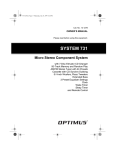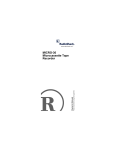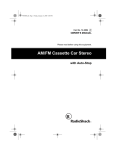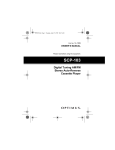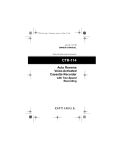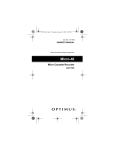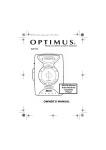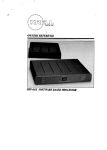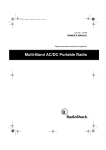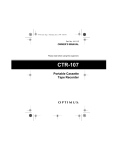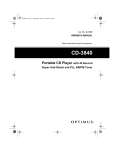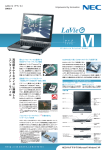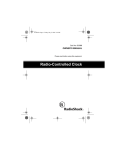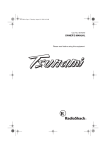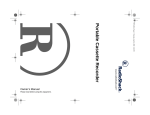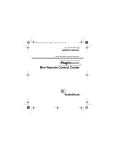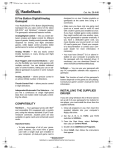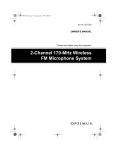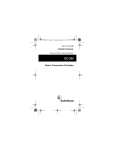Download Optimus SCR-96 Cassette Player User Manual
Transcript
14-1239a.fm Page 1 Wednesday, August 25, 1999 4:00 PM Cat. No. 14-1239 A OWNER’S MANUAL Please read before using this equipment. STEREO MATE SCR-96 AM • FM Stereo Cassette Recorder with Tie-Clip Microphone ® 14-1239a.fm Page 2 Wednesday, August 25, 1999 4:00 PM FEATURES Your Optimus Stereo Mate SCR-96 AM • FM Stereo Cassette Recorder includes a stereo microphone for recording lectures or live music. Other features include: Automatic Reverse — automatically changes the tape direction at the end of a tape side so you can continuously play both sides of a cassette tape. Tape Direction Control — lets you change the tape’s direction at any time without having to eject the tape and turn it over. Extended Bass — gives you powerful, heavy bass sound. Tape Selector — lets you select the proper equalization for normal or high-bias/metal cassette tapes. Three Power Sources — let you power your cassette recorder from internal batteries (not supplied), standard AC power (with an optional AC adapter), or your vehicle’s battery (with an optional DC adapter) so you can listen to music almost anywhere. © 1999 Tandy Corporation. All Rights Reserved. Optimus, RadioShack, Stereo Mate, and Adaptaplug are registered trademarks used by Tandy Corporation. 2 14-1239a.fm Page 3 Wednesday, August 25, 1999 4:00 PM Belt Clip — lets you attach the cassette recorder to your belt for hands-free carrying when you are on the go. Automatic Level Control — automatically sets the correct recording level. Battery Check Indicators — show you the amount of power remaining in the batteries. Note: To listen to your cassette recorder in stereo, you need a pair of headphones or amplified speakers (not supplied) with a 1/8-inch mini-plug. Your local RadioShack® store sells a wide variety of headphones and speakers. 3 14-1239a.fm Page 4 Wednesday, August 25, 1999 4:00 PM CONTENTS Preparation ........................................................... 5 Connecting to Power ....................................... 5 Using Battery Power ................................ 5 Using AC Power ....................................... 8 Using Vehicle Battery Power .................... 9 Connecting Headphones or Speakers .......... 11 Listening Safely ...................................... 11 Traffic Safety .......................................... 12 Using the Belt Clip ......................................... 12 Operation ............................................................ Playing the Radio .......................................... Loading a Cassette Tape .............................. Playing a Cassette Tape ................................ Using Fast Forward and Rewind ................... Recording ...................................................... Recording from the Radio ...................... Recording Live ....................................... Tape Tips ....................................................... Preventing Accidental Erasure ............... Erasing Tapes ........................................ Restoring Tape Tension and Sound Quality .................................................... 13 13 15 17 21 22 22 24 26 26 27 28 Care ..................................................................... 29 Cleaning the Tape-Handling Parts ................ 30 FCC Information ............................................ 31 Specifications ..................................................... 32 4 14-1239a.fm Page 5 Wednesday, August 25, 1999 4:00 PM PREPARATION CONNECTING TO POWER You can power your cassette recorder from: • Internal batteries • AC power (using an AC adapter) • Your vehicle’s cigarette-lighter socket (using a DC adapter) Using Battery Power To power the cassette recorder from internal batteries, you need two AA batteries. For the best performance and longest life, we recommend RadioShack alkaline batteries. You can also use rechargeable nickel-cadmium batteries. These batteries and a battery charger are available at your local RadioShack store. Cautions: • Use only fresh batteries of the required size and recommended type. • Do not mix old and new batteries, different types of batteries (standard, alkaline, or rechargeable), or rechargeable batteries of different capacities. 5 14-1239a.fm Page 6 Wednesday, August 25, 1999 4:00 PM Follow these steps to install batteries. 1. Open the battery compartment cover by pressing down and sliding it in the direction of the arrow on the cover, then lifting open the cover. Caution: The cover is hinged. Do not try to remove it. 2. Put the batteries in the compartment as indicated by the polarity symbols (+ and –) marked outside the compartment. 3. Close the cover. When you turn on the radio or play a tape, one of the three indicators lights up to show the amount of power remaining in the batteries. 6 Remaining Power High ➜ Low BATTERY Indicators Green ➜ F (full) Orange ➜ M (medium) Red L (low) 14-1239a.fm Page 7 Wednesday, August 25, 1999 4:00 PM When the red BATTERY indicator lights during operation, replace both batteries. Warning: Dispose of old batteries promptly and properly. Never burn or bury them. Important: This product is capable of using rechargeable nickel-cadmium batteries. At the end of the batteries’ useful life, they must be recycled or disposed of properly. Contact your local, county, or state hazardous waste management authorities for information on recycling or disposal programs in your area. Some options that might be available are: municipal curbside collection, drop-off boxes at retailers, such as your local RadioShack store, recycling collection centers, and mail-back programs. 7 14-1239a.fm Page 8 Wednesday, August 25, 1999 4:00 PM Using AC Power You can power the cassette recorder using a 3V, 200 mA AC adapter and a size H Adaptaplug® (neither supplied). Both are available at your local RadioShack store. Cautions: You must use a Class 2 power source that supplies 3V DC and delivers at least 200 mA. Its center tip must be set to negative and its plug must fit the cassette recorder's DC3V jack. Using an adapter that does not meet these specifications could damage the cassette recorder or the adapter. ! • Always connect the AC adapter to the cassette recorder before you connect it to AC power. When you finish, disconnect the adapter from AC power before you disconnect it from the cassette recorder. 8 14-1239a.fm Page 9 Wednesday, August 25, 1999 4:00 PM Follow these steps to connect the cassette recorder to AC power. 1. Set the adapter’s voltage switch to 3V. 2. Insert the size H Adaptaplug into the adapter’s cord, with the tip set to negative. 3. Insert the plug into the cassette recorder’s DC3V jack. 4. Plug the adapter into a standard AC outlet. Note: Connecting the AC adapter automatically disconnects internal batteries. Using Vehicle Battery Power You can power the cassette recorder from a vehicle’s 12V power source (such as cigarette-lighter socket) using a 3V, 200 mA DC adapter and a size H Adaptaplug® (neither supplied). Both are available at your local RadioShack store. Cautions: You must use a power source that supplies 3V DC and delivers at least 200 mA. Its center tip must be set to negative and its plug must fit the cassette recorder’s DC3V jack. Using an adapter that does ! 9 14-1239a.fm Page 10 Wednesday, August 25, 1999 4:00 PM not meet these specifications could damage the cassette recorder or the adapter. • Always connect the DC adapter to the cassette recorder before you connect it to the power source. When you finish, disconnect the adapter from the power source before you disconnect it from the cassette recorder. Follow these steps to power the cassette recorder from your vehicle’s battery. 1. Set the adapter’s voltage switch to 3V. 2. Insert the size H Adaptaplug into the adapter’s cord, with the tip set to negative. 3. Insert the plug into the cassette recorder’s DC3V jack. 4. Plug the other end of the adapter into the vehicle’s cigarette-lighter socket. 10 14-1239a.fm Page 11 Wednesday, August 25, 1999 4:00 PM CONNECTING HEADPHONES OR SPEAKERS To listen in stereo, you need a pair of headphones or amplified speakers with a 1/8-inch plug. Your local RadioShack store carries a full line of headphones and speakers. Insert the headphones’ or speakers’ plug into the cassette recorder’s jack. Listening Safely To protect your hearing, follow these guidelines when you use headphones. • Set the volume to the lowest setting before you begin listening. After you begin listening, adjust the volume to a comfortable level. • Do not listen at extremely high volume levels. Extended high-volume listening can lead to permanent hearing loss. • Once you set the volume, do not increase it. Over time, your ears adapt to the volume level, so a volume level that does not cause discomfort might still damage your hearing. 11 14-1239a.fm Page 12 Wednesday, August 25, 1999 4:00 PM Traffic Safety Do not wear headphones while operating a motor vehicle or riding a bicycle. This can create a traffic hazard and can be illegal in some areas. Even though some headphones are designed to let you hear some outside sounds when listening at normal volume levels, they still can present a traffic hazard. USING THE BELT CLIP The belt clip gives you hands-free carrying convenience. Attach the clip to the cassette recorder with the supplied screw and turn the screw in the direction of the LOCK arrow. To take off the clip, turn the screw in the direction of the RELEASE arrow. 12 14-1239a.fm Page 13 Wednesday, August 25, 1999 4:00 PM OPERATION PLAYING THE RADIO 1. To hear monaural sound through the built-in speaker, set E-BASS to SP ON. Note: When you use the built-in speaker, you cannot emphasize low frequencies with E-BASS. To hear stereo sound through headphones or amplified speakers, set E-BASS to OFF. 2. Slide TAPE/RADIO to RADIO. One of the BATTERY indicators lights. 13 14-1239a.fm Page 14 Wednesday, August 25, 1999 4:00 PM 3. Slide BAND to the desired band. Slide it to FM STEREO for stereo sound on FM stations. Notes: • The AM antenna is built-in. Move the cassette recorder to improve AM reception. • If you connect a pair of headphones or amplified speakers, fully uncoil the headphones’ or speakers’ cord for the best FM reception. • To improve reception for weak FM stereo stations, set BAND to FM MONO. The sound will be monaural, but reception should improve. 4. Rotate TUNING to select a radio station. 14 14-1239a.fm Page 15 Wednesday, August 25, 1999 4:00 PM 5. Adjust VOLUME to the desired listening level. 6. To increase the bass, slide E-BASS to ON. 7. To turn off the radio, slide TAPE/RADIO to TAPE. LOADING A CASSETTE TAPE You can use the recorder to play normal bias, highbias, and metal tapes. However, you can only use normal bias (Type I) tapes for recording. Note: Your recorder comes with a block of foam to protect the cassette recorder’s mechanism during shipment. Remove the foam before loading a tape. 15 14-1239a.fm Page 16 Wednesday, August 25, 1999 4:00 PM 1. Take up any slack in the tape by turning the cassette’s hub with a pencil. Do not touch the exposed tape. 2. Slide OPEN in the direction of the arrow and pull up on the compartment door to open it. 16 14-1239a.fm Page 17 Wednesday, August 25, 1999 4:00 PM 3. Insert a cassette into the door’s tape guides with the cassette’s open edge facing up and the full reel to the right. 4. Close the cassette compartment door. PLAYING A CASSETTE TAPE 1. Slide TAPE/RADIO to TAPE. 17 14-1239a.fm Page 18 Wednesday, August 25, 1999 4:00 PM 2. Slide TAPE/OSC (oscillator) to NORMAL for normal bias cassette tapes or to METAL/HIGH (PB) for chrome or metal cassette tapes. TAPE/OSC METAL NORMAL HIGH(PB) 3. Slide DIRECTION to FWD to play the side facing out, or to REV to play the reverse side. 18 14-1239a.fm Page 19 Wednesday, August 25, 1999 4:00 PM 4. Set the reverse mode switch to choose the automatic reverse option: One-Time Playback ( ): The cassette recorder plays one side of the tape, automatically reverses the tape’s playback direction, plays the reverse side of the tape, then automatically stops. Note: If you set DIRECTION to REV, the cassette recorder plays only the reverse side and stops at the end of that side. Continuous Playback ( ): The cassette recorder alternately plays each side of the tape until you press STOP. 19 14-1239a.fm Page 20 Wednesday, August 25, 1999 4:00 PM 5. Press PLAY. One of the BATTERY indicators lights, and the tape begins to play. 6. Adjust VOLUME to the desired listening level. 7. To increase the bass, slide E-BASS to ON. 8. To stop the tape, press STOP. 20 14-1239a.fm Page 21 Wednesday, August 25, 1999 4:00 PM USING FAST FORWARD AND REWIND When the tape is stopped, press wind or fast-forward it. DIRECTION set to To rewind, press or to re- To fastforward, press FWD REV To stop the tape before it reaches the end, press STOP. Note: To protect the tape after the tape has fully wound to either end, press STOP to release fast-forward and rewind. You can press or during playback. The button locks down and you can hear the tape at a faster speed. To return to normal playback, press PLAY. 21 14-1239a.fm Page 22 Wednesday, August 25, 1999 4:00 PM RECORDING You can record from the cassette recorder’s radio, or you can use the supplied microphone to make live recordings. Use any normal bias (Type I) tape up to 90 minutes long. We do not recommend 120-minute tapes because they are thin and can easily tangle. Important: To prevent accidental erasure, before using your SCR-96 to record, be sure DIRECTION is set to FWD. If you press RECORD with DIRECTION set to REV, the direction of tape play automatically switches to FWD. This could cause material on the other side of the tape to be recorded over. Caution: If you load a cassette with the tabs broken off, do not try to force down RECORD and PLAY at the same time. This can damage the recording mechanism. (See “Preventing Accidental Erasure” on Page 26.) Note: The cassette recorder’s automatic level control sets the recording level. Adjusting VOLUME has no effect on the recording level. Recording from the Radio 1. Load a blank cassette tape (or one you want to record over) into the tape compartment. 22 14-1239a.fm Page 23 Wednesday, August 25, 1999 4:00 PM 2. Slide TAPE/RADIO to RADIO. 3. Slide BAND to the desired band. 4. Adjust VOLUME. 5. Rotate TUNING to select a radio station. 6. Be sure DIRECTION is set to FWD, then hold down RECORD and press PLAY so recording starts. Recording continues until the tape reaches the end. To stop recording sooner, press STOP. 23 14-1239a.fm Page 24 Wednesday, August 25, 1999 4:00 PM Notes: • Set PAUSE to ON to temporarily stop recording. Set PAUSE to OFF to continue recording. • To cue the tape, you can set PAUSE to ON before you press RECORD and PLAY, and set PAUSE to OFF when you are ready to record. 7. After you stop recording, set TAPE/RADIO to TAPE to turn off the radio. Note: During playback of a recorded AM program, you might hear a high-pitched tone or a whistling sound called a “beat.” If you hear beats, set TAPE/ OSC to its other position and record again. Recording Live The supplied tie-clip microphone is like two microphones in one. It contains two elements so you can record in stereo. Follow these steps to make live recordings. 24 14-1239a.fm Page 25 Wednesday, August 25, 1999 4:00 PM 1. Load a blank cassette tape (or one you want to record over) into the tape compartment. 2. Connect the microphone to the cassette recorder’s MIC jack. Point the L/R (left/right) elements of the microphone toward the sound source as shown, or clip it to the speaker’s tie. Avoid pointing only one end (L or R) toward the sound source. 3. Set TAPE/RADIO to TAPE. 4. Be sure DIRECTION is set to FWD, then hold down RECORD and press PLAY so recording starts. Recording continues until the tape reaches the end. To stop recording sooner, press STOP. Note: Set PAUSE to ON to temporarily stop recording. Set PAUSE to OFF to continue recording. 25 14-1239a.fm Page 26 Wednesday, August 25, 1999 4:00 PM You can use stereo headphones (not supplied) to monitor the sound while you record. Note: If feedback (noise) occurs during recording, increase the distance between the microphone and the headphones, or turn down the volume. TAPE TIPS Preventing Accidental Erasure Cassettes have two erase-protection tabs — one for each side. When a tab is in place, you can record on that side. To protect a recording from being accidentally recorded over or erased, use a screwdriver to remove one or both of the cassette tape’s erase-protection tabs. This prevents RECORD from being pressed. A 26 14-1239a.fm Page 27 Wednesday, August 25, 1999 4:00 PM If you later decide to record on a tape side after you have removed its erase-protection tab, place a piece of strong plastic tape over the side’s erase-protection hole. Be sure you cover only the hole originally covered by the erase-protection tab. Caution: Removing the erase-protection tabs does not prevent a bulk tape eraser from erasing a cassette tape. Erasing Tapes If you record on a previously recorded tape, you replace the old recording with the new. You can also erase part or all of a tape without recording new material by following these steps: 1. Load a cassette and disconnect the microphone, if it is connected. 2. Set TAPE/RADIO to TAPE. 3. Press RECORD and PLAY. As the tape moves, it is erased. 4. Press STOP to stop erasing. If you want to quickly erase a cassette, you can use a bulk eraser (Cat. No. 44-232). 27 14-1239a.fm Page 28 Wednesday, August 25, 1999 4:00 PM Restoring Tape Tension and Sound Quality After you play a cassette tape several times, the tape might become tightly wound on the reels. This can cause playback sound quality to deteriorate. To restore the sound quality, fast-forward the tape from the beginning to the end of one side, then completely rewind it. Then loosen the tape reels by gently tapping each side of the cassette’s outer shell on a flat surface. Caution: Be careful not to damage the cassette when tapping it. Do not touch the exposed tape or allow any sharp objects near the cassette. 28 14-1239a.fm Page 29 Wednesday, August 25, 1999 4:00 PM CARE Your Optimus Stereo Mate SCR-96 AM • FM Stereo Cassette Recorder is an example of superior design and craftsmanship. The following suggestions will help you care for the cassette recorder so you can enjoy it for years. • Keep the recorder dry. If it gets wet, wipe it dry immediately. • Use only fresh batteries of the recommended size and type. • Handle the recorder gently and carefully. • Use and store the recorder only in normal temperature environments. Temperature extremes can shorten the life of electronic devices damage batteries, and distort or melt plastic parts. • Keep the recorder away from dust and dirt. • Wipe the recorder with a damp cloth occasionally to keep it looking new. Do not use harsh chemicals, cleaning solvents, or strong detergents to clean the recorder. Modifying or tampering with the recorder’s internal components can cause a malfunction and might invalidate the recorder’s warranty and void your FCC authorization to use it. If your recorder is not performing as it should, take it to your local RadioShack store for assistance. 29 14-1239a.fm Page 30 Wednesday, August 25, 1999 4:00 PM CLEANING THE TAPE-HANDLING PARTS Dirt, dust, or particles of the tape’s coating can accumulate on the tape heads and other parts the tape touches. This can greatly reduce the performance of the cassette recorder. You should clean the tapehandling parts after about every 20 hours of tape player operation. Your local RadioShack store sells a complete line of cassette deck cleaning supplies. 1. Remove the batteries and disconnect any other power source. 2. Open the cassette compartment cover. PLAY to expose the tape-handling 3. Press parts. 4. Use a cotton swab dipped in denatured alcohol or tape head cleaning solution to clean the playback head, pinch rollers, tape guides, and capstans. Pinch Rollers Capstan Tape Guide Playback Head 30 Tape Guide Capstan 14-1239a.fm Page 31 Wednesday, August 25, 1999 4:00 PM 5. When you finish cleaning, press STOP and close the cassette compartment cover. Then reconnect power. FCC INFORMATION This device complies with Part 15 of the FCC Rules. Operation is subject to the following two conditions: (1) This device may not cause harmful interference, and (2) this device must accept any interference received, including interference that may cause undesired operation. Consult your local Radio Shack store if the problem still exists. 31 14-1239a.fm Page 32 Wednesday, August 25, 1999 4:00 PM SPECIFICATIONS CASSETTE DECK Tape Speed .................................. 17/8 ips (4.8 cm/s) Wow and Flutter (WRMS) ................................. 0.5% Frequency Response (at –3 dB) ..... 63 Hz to 15 kHz S/N Ratio ........................................................ 47 dB RADIO AM .................................................. 530 to 1710 kHz FM .................................................... 88 to 108 MHz POWER REQUIREMENT Batteries ............................................ 2 AA Batteries AC .................................. 120 Volts with AC Adapter (Cat. No. 273-1654) DC .............................. 12 Volts DC with DC Adapter (Cat. No. 273-1810) Typical Radio Playing Time with AA Alkaline Batteries ............... About 39 Hours Typical Cassette Playing Time with AA Alkaline Batteries ............... About 19 Hours 32 14-1239a.fm Page 33 Wednesday, August 25, 1999 4:00 PM GENERAL Power Output ............... 15 mW/Channel at 32 ohms Dimensions (HWD) ............. 35/8 × 43/4 × 15/16 Inches (92 × 119 × 33 mm) Weight (Without Battery) ................................. 6.2 oz (175 g) Specifications are typical; individual units might vary. Specifications are subject to change and improvement without notice. 33 14-1239a.fm Page 34 Wednesday, August 25, 1999 4:00 PM NOTES 34 14-1239a.fm Page 35 Wednesday, August 25, 1999 4:00 PM 35 14-1239a.fm Page 36 Wednesday, August 25, 1999 4:00 PM Limited Ninety-Day Warranty This product is warranted by RadioShack against manufacturing defects in material and workmanship under normal use for ninety (90) days from the date of purchase from RadioShack company-owned stores and authorized RadioShack franchisees and dealers. EXCEPT AS PROVIDED HEREIN, RadioShack MAKES NO EXPRESS WARRANTIES AND ANY IMPLIED WARRANTIES, INCLUDING THOSE OF MERCHANTABILITY AND FITNESS FOR A PARTICULAR PURPOSE, ARE LIMITED IN DURATION TO THE DURATION OF THE WRITTEN LIMITED WARRANTIES CONTAINED HEREIN. EXCEPT AS PROVIDED HEREIN, RadioShack SHALL HAVE NO LIABILITY OR RESPONSIBILITY TO CUSTOMER OR ANY OTHER PERSON OR ENTITY WITH RESPECT TO ANY LIABILITY, LOSS OR DAMAGE CAUSED DIRECTLY OR INDIRECTLY BY USE OR PERFORMANCE OF THE PRODUCT OR ARISING OUT OF ANY BREACH OF THIS WARRANTY, INCLUDING, BUT NOT LIMITED TO, ANY DAMAGES RESULTING FROM INCONVENIENCE, LOSS OF TIME, DATA, PROPERTY, REVENUE, OR PROFIT OR ANY INDIRECT, SPECIAL, INCIDENTAL, OR CONSEQUENTIAL DAMAGES, EVEN IF RadioShack HAS BEEN ADVISED OF THE POSSIBILITY OF SUCH DAMAGES. Some states do not allow the limitations on how long an implied warranty lasts or the exclusion of incidental or consequential damages, so the above limitations or exclusions may not apply to you. In the event of a product defect during the warranty period, take the product and the RadioShack sales receipt as proof of purchase date to any RadioShack store. RadioShack will, at its option, unless otherwise provided by law: (a) correct the defect by product repair without charge for parts and labor; (b) replace the product with one of the same or similar design; or (c) refund the purchase price. All replaced parts and products, and products on which a refund is made, become the property of RadioShack. New or reconditioned parts and products may be used in the performance of warranty service. Repaired or replaced parts and products are warranted for the remainder of the original warranty period. You will be charged for repair or replacement of the product made after the expiration of the warranty period. This warranty does not cover: (a) damage or failure caused by or attributable to acts of God, abuse, accident, misuse, improper or abnormal usage, failure to follow instructions, improper installation or maintenance, alteration, lightning or other incidence of excess voltage or current; (b) any repairs other than those provided by a RadioShack Authorized Service Facility; (c) consumables such as fuses or batteries; (d) cosmetic damage; (e) transportation, shipping or insurance costs; or (f) costs of product removal, installation, set-up service adjustment or reinstallation. This warranty gives you specific legal rights, and you may also have other rights which vary from state to state. RadioShack Customer Relations, 200 Taylor St., 6th Floor, Fort Worth, TX 76102 We Service What We Sell 07A99 04/99 84-HJ6-904-31 990525DKK-RS9 Printed in Malaysia




































